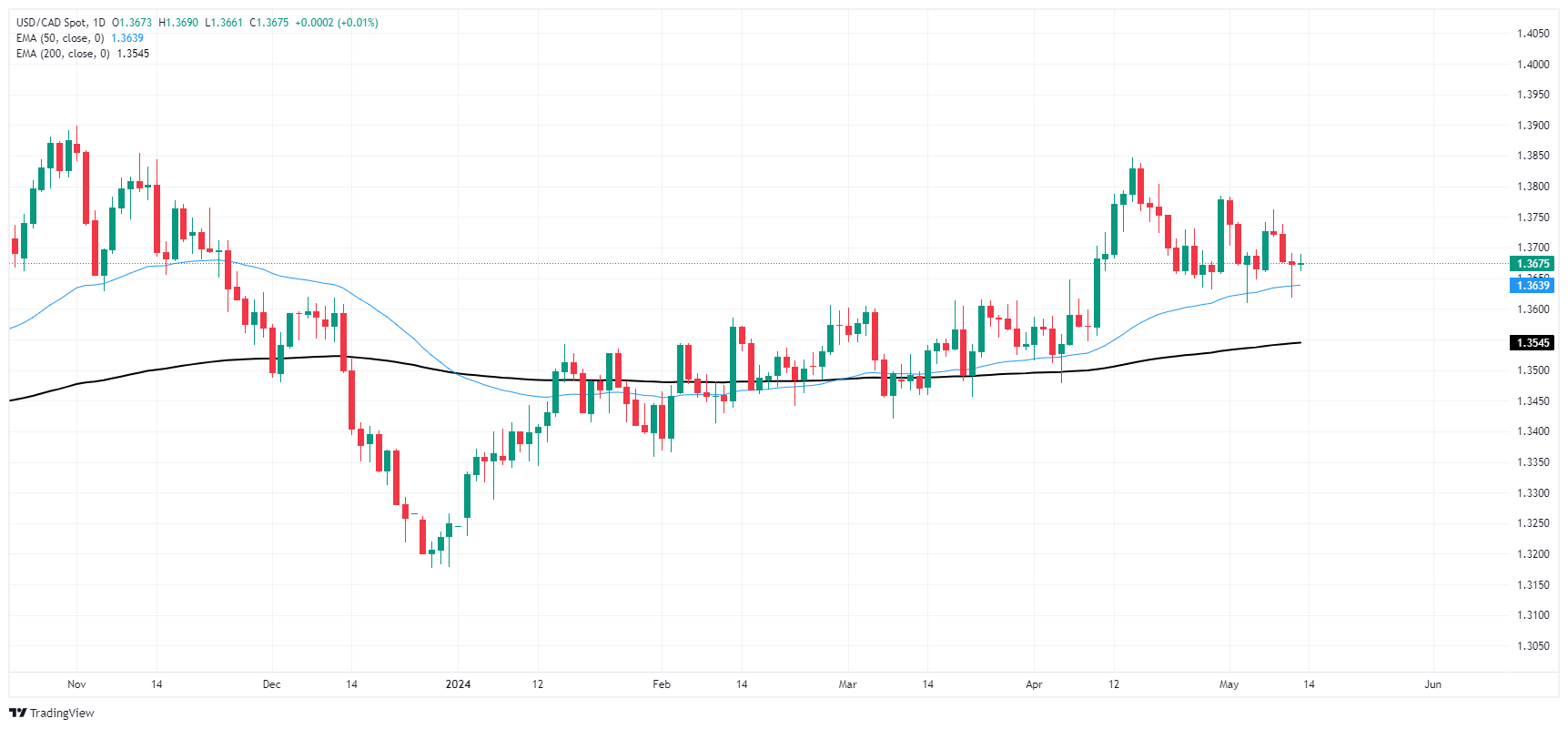Canadian Dollar middles as markets focus on Fed rate cuts.
Canada issued far fewer building permits than expected in March.
Markets continue to bet on two rate cuts in 2024 despite cautionary Fedspeak.
The Canadian Dollar (CAD) churned within familiar levels on Monday as a data-light economic calendar kicks off the new trading week. Investors continue to hinge risk appetite on rate cut expectations from the Federal Reserve (Fed) with updates to US inflation data due later in the week.
Canada saw a sharper-than-expected decline in new Building Permits issued in March, but data from early in the housing cycle remains low-tier and limited-impact. Canadian economic data remains low-priority for the rest of the week, leaving market participants to focus on the US Producer Price Index (PPI) due on Tuesday, followed by US Consumer Price Index (CPI) inflation and Retail Sales on Wednesday.
Daily digest market movers: Canadian Dollar stuck in the middle as rate cut hopes dominate
Canadian Building Permits issued in March declined -11.7%, far below the -4.6% forecast, the sharpest decline in MoM Building Permits since June of 2023. April’s Building Permits were also revised slightly lower to 8.9% from 9.3%.
The latest Survey of Consumer Expectations from the New York Fed noted that surveyed consumers expect inflation to rise to 3.3% over the next year, higher than the previous survey’s 3.0%.
A Reuters survey of 108 economists showed nearly two-thirds of respondents still expect a quarter-point cut from the Fed by September despite none expecting inflation to reach the Fed’s 2% target before 2026.
YoY US Producer Price Index inflation is expected to rise to 2.2% on Tuesday, compared to the previous period’s 2.1%.
Wednesday’s US CPI inflation print for April is forecast to hold steady at 0.4% MoM, with the YoY figure expected to tick down to 3.4% from 3.5%.
Canadian Dollar PRICE Today
The table below shows the percentage change of Canadian Dollar (CAD) against listed major currencies today. Canadian Dollar was the strongest against the British Pound.
USD
EUR
GBP
JPY
CAD
AUD
NZD
CHF
USD
0.22%
0.28%
-0.27%
-0.05%
0.12%
-0.11%
-0.14%
EUR
-0.22%
0.11%
-0.49%
-0.25%
-0.07%
-0.31%
-0.34%
GBP
-0.28%
-0.11%
-0.53%
-0.37%
-0.19%
-0.42%
-0.45%
JPY
0.27%
0.49%
0.53%
0.25%
0.36%
0.22%
0.12%
CAD
0.05%
0.25%
0.37%
-0.25%
0.14%
-0.05%
-0.00%
AUD
-0.12%
0.07%
0.19%
-0.36%
-0.14%
-0.13%
-0.27%
NZD
0.11%
0.31%
0.42%
-0.22%
0.05%
0.13%
-0.03%
CHF
0.14%
0.34%
0.45%
-0.12%
0.00%
0.27%
0.03%
The heat map shows percentage changes of major currencies against each other. The base currency is picked from the left column, while the quote currency is picked from the top row. For example, if you pick the Canadian Dollar from the left column and move along the horizontal line to the US Dollar, the percentage change displayed in the box will represent CAD (base)/USD (quote).
Technical analysis: Canadian Dollar middles as markets hold steady
The Canadian Dollar (CAD) trades tightly on Monday, sticking close to the new trading week’s opening bids. The CAD is trading within a quarter of a percent against nearly all of its major currency peers on Monday and holding next to flat against the US Dollar (USD).
The USD/CAD is struggling to find momentum on Monday, holding in place near 1.3680. Bids are treading water just above a near-term supply zone from 1.3660 to 1.3615. Topside momentum is capped by the 200-hour Exponential Moving Average (EMA) just below the 1.3700 handle, while short-sellers have been unsuccessful in dragging the pair back down to 1.3600.
USD/CAD hourly chart
USD/CAD daily chart
Interest rates FAQs
Interest rates are charged by financial institutions on loans to borrowers and are paid as interest to savers and depositors. They are influenced by base lending rates, which are set by central banks in response to changes in the economy. Central banks normally have a mandate to ensure price stability, which in most cases means targeting a core inflation rate of around 2%. If inflation falls below target the central bank may cut base lending rates, with a view to stimulating lending and boosting the economy. If inflation rises substantially above 2% it normally results in the central bank raising base lending rates in an attempt to lower inflation.
Higher interest rates generally help strengthen a country’s currency as they make it a more attractive place for global investors to park their money.
Higher interest rates overall weigh on the price of Gold because they increase the opportunity cost of holding Gold instead of investing in an interest-bearing asset or placing cash in the bank. If interest rates are high that usually pushes up the price of the US Dollar (USD), and since Gold is priced in Dollars, this has the effect of lowering the price of Gold.
The Fed funds rate is the overnight rate at which US banks lend to each other. It is the oft-quoted headline rate set by the Federal Reserve at its FOMC meetings. It is set as a range, for example 4.75%-5.00%, though the upper limit (in that case 5.00%) is the quoted figure. Market expectations for future Fed funds rate are tracked by the CME FedWatch tool, which shapes how many financial markets behave in anticipation of future Federal Reserve monetary policy decisions.
Information on these pages contains forward-looking statements that involve risks and uncertainties. Markets and instruments profiled on this page are for informational purposes only and should not in any way come across as a recommendation to buy or sell in these assets. You should do your own thorough research before making any investment decisions. FXStreet does not in any way guarantee that this information is free from mistakes, errors, or material misstatements. It also does not guarantee that this information is of a timely nature. Investing in Open Markets involves a great deal of risk, including the loss of all or a portion of your investment, as well as emotional distress. All risks, losses and costs associated with investing, including total loss of principal, are your responsibility. The views and opinions expressed in this article are those of the authors and do not necessarily reflect the official policy or position of FXStreet nor its advertisers. The author will not be held responsible for information that is found at the end of links posted on this page.
If not otherwise explicitly mentioned in the body of the article, at the time of writing, the author has no position in any stock mentioned in this article and no business relationship with any company mentioned. The author has not received compensation for writing this article, other than from FXStreet.
FXStreet and the author do not provide personalized recommendations. The author makes no representations as to the accuracy, completeness, or suitability of this information. FXStreet and the author will not be liable for any errors, omissions or any losses, injuries or damages arising from this information and its display or use. Errors and omissions excepted.
The author and FXStreet are not registered investment advisors and nothing in this article is intended to be investment advice.
>>> Read full article>>>
Copyright for syndicated content belongs to the linked Source : FXStreet – https://www.fxstreet.com/news/canadian-dollar-treads-water-on-tepid-monday-202405131619















![[News] Japan Develops 10nm Nanoimprint Technology, with Potential to Tackle EUV Bottleneck – TrendForce](https://earth-news.info/wp-content/uploads/2025/12/329851-news-japan-develops-10nm-nanoimprint-technology-with-potential-to-tackle-euv-bottleneck-trendforce-360x180.jpg)















